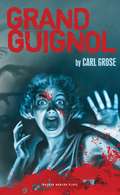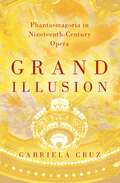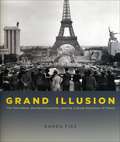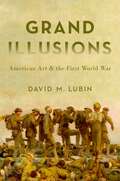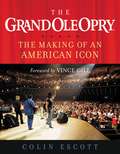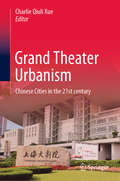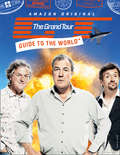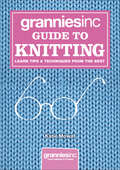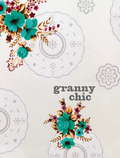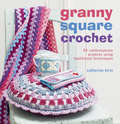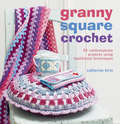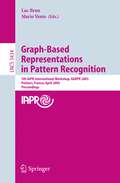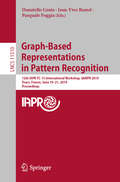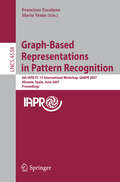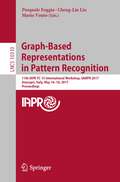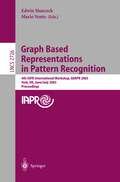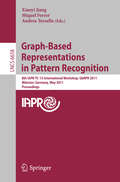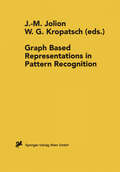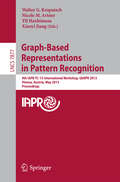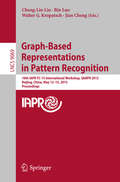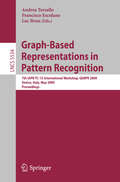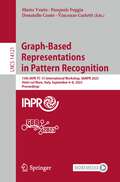- Table View
- List View
Grand Guignol (Oberon Modern Plays)
by Carl Grose1903. In the back streets of Montmartre, the Theatre du Grand Guignol opens its doors to an unsuspecting public. The plays performed, rife with madness and murder, are sold out every night. A psychiatrist obsessed with the playwright’s gruesome dramas ingratiates his way into the company. But when he starts to unpick the author’s mind, the boundaries between theatre and truth begin to blur… Delighting in this lost theatrical form, Carl Grose’s demented new play works fast and loose with convention. A black comedy, a psychological thriller and an unrepentant splatterfest, Grand Guignol is a head-spinning, genre-bending phantasmagoria guaranteed to keep you guessing (and wincing) to the very last horror show…
Grand Illusion: Phantasmagoria in Nineteenth-Century Opera
by Gabriela CruzA new and groundbreaking approach to the history of grand opera, Grand Illusion: Phantasmagoria in Nineteenth-Century Opera explores the illusion and illumination behind the form's rise to cultural eminence. Renowned opera scholar Gabriela Cruz argues that grand opera worked to awaken memory and feeling in a way never before experienced in the opera house, asserting that the concept of "spectacle" was the defining cultural apparatus of the art form after the 1820s. Parisian audiences at the Académie Royale de Musique were struck by the novelty and power of grand opera upon the introduction of gaslight illumination, a technological innovation that quickly influenced productions across the Western operatic world. With this innovation, grand opera transformed into an audio-visual spectacle, delivering dream-like images and evoking the ghosts of its audiences' past. Through case studies of operas by Giacomo Meyerbeer, Richard Wagner, and Giuseppe Verdi, Cruz demonstrates how these works became an increasingly sophisticated medium by which audiences could conjure up the past and be transported away from the breakdown of modern life. A historically informed narrative that traverses far and wide, from dingy popular theatres in post-revolutionary Paris, to nautical shows in London, and finally to Egyptian mummies, Grand Illusion provides a fresh departure from previous scholarship, highlighting the often-neglected visual side of grand opera.
Grand Illusion: Phantasmagoria in Nineteenth-Century Opera
by Gabriela CruzA new and groundbreaking approach to the history of grand opera, Grand Illusion: Phantasmagoria in Nineteenth-Century Opera explores the illusion and illumination behind the form's rise to cultural eminence. Renowned opera scholar Gabriela Cruz argues that grand opera worked to awaken memory and feeling in a way never before experienced in the opera house, asserting that the concept of "spectacle" was the defining cultural apparatus of the art form after the 1820s. Parisian audiences at the Académie Royale de Musique were struck by the novelty and power of grand opera upon the introduction of gaslight illumination, a technological innovation that quickly influenced productions across the Western operatic world. With this innovation, grand opera transformed into an audio-visual spectacle, delivering dream-like images and evoking the ghosts of its audiences' past. Through case studies of operas by Giacomo Meyerbeer, Richard Wagner, and Giuseppe Verdi, Cruz demonstrates how these works became an increasingly sophisticated medium by which audiences could conjure up the past and be transported away from the breakdown of modern life. A historically informed narrative that traverses far and wide, from dingy popular theatres in post-revolutionary Paris, to nautical shows in London, and finally to Egyptian mummies, Grand Illusion provides a fresh departure from previous scholarship, highlighting the often-neglected visual side of grand opera.
Grand Illusion: The Third Reich, the Paris Exposition, and the Cultural Seduction of France
by Karen FissFranco-German cultural exchange reached its height at the 1937 Paris World’s Fair, where the Third Reich worked to promote an illusion of friendship between the two countries. Through the prism of this decisive event, Grand Illusion examines the overlooked relationships among Nazi elites and French intellectuals. Their interaction, Karen Fiss argues, profoundly influenced cultural production and normalized aspects of fascist ideology in 1930s France, laying the groundwork for the country’s eventual collaboration with its German occupiers. Tracing related developments across fine arts, film, architecture, and mass pageantry, Fiss illuminates the role of National Socialist propaganda in the French decision to ignore Hitler’s war preparations and pursue an untenable policy of appeasement. France’s receptiveness toward Nazi culture, Fiss contends, was rooted in its troubled identity and deep-seated insecurities. With their government in crisis, French intellectuals from both the left and the right demanded a new national culture that could rival those of the totalitarian states. By examining how this cultural exchange shifted toward political collaboration, Grand Illusion casts new light on the power of art to influence history.
Grand Illusions: American Art and the First World War
by David M. LubinA vivid, engaging account of the artists and artworks that sought to make sense of America's first total war, Grand Illusions takes readers on a compelling journey through the major historical events leading up to and beyond US involvement in WWI to discover the vast and pervasive influence of the conflict on American visual culture. David M. Lubin presents a highly original examination of the era's fine arts and entertainment to show how they ranged from patriotic idealism to profound disillusionment. In stylishly written chapters, Lubin assesses the war's impact on two dozen painters, designers, photographers, and filmmakers from 1914 to 1933. He considers well-known figures such as Marcel Duchamp, John Singer Sargent, D. W. Griffith, and the African American outsider artist Horace Pippin while resurrecting forgotten artists such as the mask-maker Anna Coleman Ladd, the sculptor Gertrude Vanderbilt Whitney, and the combat artist Claggett Wilson. The book is liberally furnished with illustrations from epoch-defining posters, paintings, photographs, and films. Armed with rich cultural-historical details and an interdisciplinary narrative approach, David Lubin creatively upends traditional understandings of the Great War's effects on the visual arts in America.
Grand Illusions: American Art and the First World War
by David M. LubinA vivid, engaging account of the artists and artworks that sought to make sense of America's first total war, Grand Illusions takes readers on a compelling journey through the major historical events leading up to and beyond US involvement in WWI to discover the vast and pervasive influence of the conflict on American visual culture. David M. Lubin presents a highly original examination of the era's fine arts and entertainment to show how they ranged from patriotic idealism to profound disillusionment. In stylishly written chapters, Lubin assesses the war's impact on two dozen painters, designers, photographers, and filmmakers from 1914 to 1933. He considers well-known figures such as Marcel Duchamp, John Singer Sargent, D. W. Griffith, and the African American outsider artist Horace Pippin while resurrecting forgotten artists such as the mask-maker Anna Coleman Ladd, the sculptor Gertrude Vanderbilt Whitney, and the combat artist Claggett Wilson. The book is liberally furnished with illustrations from epoch-defining posters, paintings, photographs, and films. Armed with rich cultural-historical details and an interdisciplinary narrative approach, David Lubin creatively upends traditional understandings of the Great War's effects on the visual arts in America.
The Grand Ole Opry: The Making of an American Icon
by Colin EscottThis official guide chronicles the story of the birthplace of country music as told by the people who were there. Escott presents the official inside history of the home of country music, offering fans an exclusive look into the heart and soul of country music. Full color, and packed with photos from the Opry Archives covering 80 years of history.
Grand Theater Urbanism: Chinese Cities in the 21st century
by Charlie Qiuli XueThis volume explores the phenomenon and trend of cultural buildings by investigating 10 typical cities in China from the first, second, and third tiers, and from the Chinese diaspora. Each grand theater design was the result of a high-profile international competition and created by global architects in collaboration with Chinese design institutes. The national and international significance of these iconic projects lies in the fact that they not only reflect the dynamics of global design ideas, but also represent a particular historical moment in China’s modernization process. The development, histories, and purposes of constructing cultural buildings are carefully outlined and colorfully presented. Given China’s tremendous population, the development trajectory of its urban construction will provide insights for other regions that hope to embark on the high-speed track in the 21st century.“In 'Grand Theater Urbanism', Professor Charlie Xue and his team document China’s current shift towards a culture of consumption and leisure, symbolized by the construction of multi-use Grand Theaters in major cities. 'Grand Theater Urbanism' reveals the unexpected variety and complexity of this contemporary cultural drive in a series of exemplary chapters with highly detailed, local, case studies.” --Professor David Grahame Shane, Columbia University, New York "Jane Jacobs likened city life to a performance. This book goes a stage further and analyses the actual performance spaces within cities in China. In doing so it makes a valuable connection between urban design and the cultural life in cities. This is an important and often forgotten dimension of urbanism and I heartily commend this book to readers.'" --Professor Matthew Carmona, The Bartlett, University College London
The Grand Tour Guide to the World
by HarperCollinsThe world is a big place full of interesting things. And The Grand Tour has seen some of them. That’s why few people are better placed to lead you around this vast planet of ours than Jeremy Clarkson, Richard Hammond and James May. As long as you don’t mind getting hot and lost. Welcome, everyone, to The Grand Tour Guide to The World.
Grannies, Inc. Guide to Knitting: Learn Tips, Techniques and Patterns from the Best
by Katie MowatWhen it comes to knitting, who knows better than our nan? If you get tangled in a ball of wool, she's always the first person you call to help you sort your cross stitch from your cable.While recruiting for her fledgling online knitwear company, Katie Mowat swiftly realised that it was mainly older women, namely grannies, who were volunteering their services, and so Grannies Inc. was born. Since 2009 they have gone from strength to strength, and from one product (beanies), they now design and produce a whole range of knitwear. Her crack squad of 15 grannies will be contributing their 'purls' of wisdom and patterns to help the new knitting generation in this attractive book. With knitting patterns for snoods, legwarmers, slouch socks, laptop cases and beanies, you'll be cool and cosy in no time. As the grannies say, 'May your bobbin always be full.'
Granny Chic: Crafty recipes and inspiration for the handmade home
by Rachelle Blondel Tif FussellMore than just a 'how-to' guide, Granny Chic offers inspiration to keen crafters hoping to breathe new life into vintage fabrics and second-hand objects. From handmade notebooks to lace lampshades and pinnies made from tea towels, each of the craft 'recipes' brings the granny chic look to life while allowing you to give them your own personal twist. This selection of 20 projects includes spruced-up coat hangers, a 'dingle dangle' door screen, a 'patched and pieced' lampshade and a crocheted tea cosy. In addition to the projects, Granny Chic offers advice on the granny chic lifestyle, from befriending your local fabric shop to creating a handmade home. Packed full of ideas, it will have you rustling in your vintage fabric to find your inner granny chic crafting soul.
Granny Square Crochet: 35 contemporary projects using traditional techniques
by Catherine HirstMake over 35 fabulous projects, from quick and easy scarves to mug cosies. The granny square is the starting point for many people when they first learn to crochet, but as their skills progress, this versatile crochet block is often forgotten. In Granny Square Crochet , crochet teacher Catherine Hirst presents 35 projects which show how this traditional square can be updated and used in many different ways. The first chapter has over a dozen projects for the home, ranging from a blue-and-white mug cosy which can be made in less than an hour, to a stunning bed cover. There are cushions and seat covers to brighten up your living room, plus place mats, drinks coasters and a runner for your table. The second chapter has some great accessories, including gloves, scarves and bags, and even a dog coat to keep your favourite hound warm in winter. The third chapter has a great range of patterns to make as gifts for children and babies, such as crib and pram blankets, bibs, hats and toys. Each project is graded according to the level of skill required, and there is a comprehensive basic techniques chapter explaining all you need to know. Catherine Hirst was taught crochet at a young age by her grandmother and took to it immediately - she quickly learned to knit and embroider as well, and has been hand-making clothing, accessories, and gifts ever since. Her first book, Teeny Tiny Crochet , is also published by CICO Books.
Granny Square Crochet: 35 contemporary projects using traditional techniques
by Catherine HirstMake over 35 fabulous projects, from quick and easy scarves to mug cosies. The granny square is the starting point for many people when they first learn to crochet, but as their skills progress, this versatile crochet block is often forgotten. In Granny Square Crochet , crochet teacher Catherine Hirst presents 35 projects which show how this traditional square can be updated and used in many different ways. The first chapter has over a dozen projects for the home, ranging from a blue-and-white mug cosy which can be made in less than an hour, to a stunning bed cover. There are cushions and seat covers to brighten up your living room, plus place mats, drinks coasters and a runner for your table. The second chapter has some great accessories, including gloves, scarves and bags, and even a dog coat to keep your favourite hound warm in winter. The third chapter has a great range of patterns to make as gifts for children and babies, such as crib and pram blankets, bibs, hats and toys. Each project is graded according to the level of skill required, and there is a comprehensive basic techniques chapter explaining all you need to know. Catherine Hirst was taught crochet at a young age by her grandmother and took to it immediately - she quickly learned to knit and embroider as well, and has been hand-making clothing, accessories, and gifts ever since. Her first book, Teeny Tiny Crochet , is also published by CICO Books.
Granny's Kitchen Cupboard: A Lifetime In Over 100 Objects
by John AlexanderAccumulated over many years, 'Granny', the enigmatic collector behind this book, presents a selection of quirky post-war goods, advertising and kitchen items.
Graph-Based Representations in Pattern Recognition: 5th IAPR International Workshop, GbRPR 2005, Poitiers, France, April 11-13, 2005, Proceedings (Lecture Notes in Computer Science #3434)
by Luc Brun Mario VentoMany vision problems have to deal with di?erent entities (regions, lines, line junctions, etc.) and their relationships. These entities together with their re- tionships may be encoded using graphs or hypergraphs. The structural inf- mation encoded by graphs allows computer vision algorithms to address both the features of the di?erent entities and the structural or topological relati- ships between them. Moreover, turning a computer vision problem into a graph problem allows one to access the full arsenal of graph algorithms developed in computer science. The Technical Committee (TC15, http://www.iapr.org/tcs.html) of the IAPR (International Association for Pattern Recognition) has been funded in order to federate and to encourage research work in these ?elds. Among its - tivities, TC15 encourages the organization of special graph sessions at many computer vision conferences and organizes the biennial workshop GbR. While being designed within a speci?c framework, the graph algorithms developed for computer vision and pattern recognition tasks often share constraints and goals with those developed in other research ?elds such as data mining, robotics and discrete geometry. The TC15 community is thus not closed in its research ?elds but on the contrary is open to interchanges with other groups/communities.
Graph-Based Representations in Pattern Recognition: 12th IAPR-TC-15 International Workshop, GbRPR 2019, Tours, France, June 19–21, 2019, Proceedings (Lecture Notes in Computer Science #11510)
by Donatello Conte Jean-Yves Ramel Pasquale FoggiaThis book constitutes the refereed proceedings of the 12th IAPR-TC-15 International Workshop on Graph-Based Representation in Pattern Recognition, GbRPR 2019, held in Tours, France, in June 2019.The 22 full papers included in this volume together with an invited talk were carefully reviewed and selected from 28 submissions. The papers discuss research results and applications at the intersection of pattern recognition, image analysis, and graph theory. They cover topics such as graph edit distance, graph matching, machine learning for graph problems, network and graph embedding, spectral graph problems, and parallel algorithms for graph problems.
Graph-Based Representations in Pattern Recognition: 6th IAPR-TC-15 International Workshop, GbRPR 2007, Alicante, Spain, June 11-13, 2007, Proceedings (Lecture Notes in Computer Science #4538)
by Francisco Escolano Mario VentoThis book constitutes the refereed proceedings of the 6th IAPR-TC-15 International Workshop on Graph-Based Representations in Pattern Recognition, GbRPR 2007, held in Alicante, Spain in June 2007. It covers matching, distances and measures, graph-based segmentation and image processing, graph-based clustering, graph representations, pyramids, combinatorial maps and homologies, as well as graph clustering, embedding and learning.
Graph-Based Representations in Pattern Recognition: 11th IAPR-TC-15 International Workshop, GbRPR 2017, Anacapri, Italy, May 16–18, 2017, Proceedings (Lecture Notes in Computer Science #10310)
by Pasquale Foggia Cheng-Lin Liu Mario VentoThis book constitutes the refereed proceedings of the 11th IAPR-TC-15 International Workshop on Graph-Based Representation in Pattern Recognition, GbRPR 2017, held in Anacapri, Italy, in May 2017. The 25 full papers and 2 abstracts of invited papers presented in this volume were carefully reviewed and selected from 31 submissions. The papers discuss research results and applications in the intersection of pattern recognition, image analysis, graph theory, and also the application of graphs to pattern recognition problems in other fields like computational topology, graphic recognition systems and bioinformatics.
Graph Based Representations in Pattern Recognition: 4th IAPR International Workshop, GbRPR 2003, York, UK, June 30 - July 2, 2003. Proceedings (Lecture Notes in Computer Science #2726)
by Edwin Hancock Mario VentoThe refereed proceedings of the 4th IAPR International Workshop on Graph-Based Representation in Pattern Recognition, GbRPR 2003, held in York, UK in June/July 2003. The 23 revised full papers presented were carefully reviewed and selected for inclusion in the book. The papers are organized in topical sections on data structures and representation, segmentation, graph edit distance, graph matching, matrix methods, and graph clustering.
Graph-Based Representations in Pattern Recognition: 8th IAPR-TC-15 International Workshop, GbRPR 2011, Münster, Germany, May 18-20, 2011, Proceedings (Lecture Notes in Computer Science #6658)
by Xiaoyi Jiang Miquel Ferrer Andrea TorselloThis book constitutes the refereed proceedings of the 8th IAPR-TC-15 International Workshop on Graph-Based Representations in Pattern Recognition, GbRPR 2011, held in Münster, Germany, in May 2011. The 34 revised full papers presented were carefully reviewed and selected from numerous submissions. The papers are organized in topical sections on graph-based representation and characterization, graph matching, classification, and querying, graph-based learning, graph-based segmentation, and applications.
Graph Based Representations in Pattern Recognition (Computing Supplementa #12)
by Jean-Michel Jolion Walter KropatschGraph-based representation of images is becoming a popular tool since it represents in a compact way the structure of a scene to be analyzed and allows for an easy manipulation of sub-parts or of relationships between parts. Therefore, it is widely used to control the different levels from segmentation to interpretation. The 14 papers in this volume are grouped in the following subject areas: hypergraphs, recognition and detection, matching, segmentation, implementation problems, representation.
Graph-Based Representations in Pattern Recognition: 9th IAPR-TC-15 International Workshop, GbRPR 2013, Vienna, Austria, May 15-17, 2013, Proceedings (Lecture Notes in Computer Science #7877)
by Walter Kropatsch Nicole M. Artner Yll Haxhimusa Xiaoyi JiangThis book constitutes the refereed proceedings of the 9th IAPR-TC-15 International Workshop on Graph-Based Representations in Pattern Recognition, GbRPR 2013, held in Vienna, Austria, in May 2013. The 24 papers presented in this volume were carefully reviewed and selected from 27 submissions. They are organized in topical sections named: finding subregions in graphs; graph matching; classification; graph kernels; properties of graphs; topology; graph representations, segmentation and shape; and search in graphs.
Graph-Based Representations in Pattern Recognition: 10th IAPR-TC-15 International Workshop, GbRPR 2015, Beijing, China, May 13-15, 2015. Proceedings (Lecture Notes in Computer Science #9069)
by Cheng-Lin Liu Bin Luo Walter G. Kropatsch Jian ChengThis book constitutes the refereed proceedings of the 10th IAPR-TC-15 International Workshop on Graph-Based Representations in Pattern Recognition, GbRPR 2015, held in Beijing, China, in May 2015. The 36 papers presented in this volume were carefully reviewed and selected from 53 submissions. The accepted papers cover diverse issues of graph-based methods and applications, with 7 in graph representation, 15 in graph matching, 7 in graph clustering and classification, and 7 in graph-based applications.
Graph-Based Representations in Pattern Recognition: 7th IAPR-TC-15 International Workshop, GbRPR 2009, Venice, Italy, May 26-28, 2009. Proceedings (Lecture Notes in Computer Science #5534)
by Andrea Torsello Francisco Escolano Ruiz Luc BrunGraph-Based Representations in Pattern Recognition: 13th IAPR-TC-15 International Workshop, GbRPR 2023, Vietri sul Mare, Italy, September 6–8, 2023, Proceedings (Lecture Notes in Computer Science #14121)
by Mario Vento Pasquale Foggia Donatello Conte Vincenzo CarlettiThis book constitutes the refereed proceedings of the 13th IAPR-TC-15 International Workshop on Graph-Based Representations in Pattern Recognition, GbRPR 2023, which took place in Vietri sul Mare, Italy, in September 2023.The 16 full papers included in this book were carefully reviewed and selected from 18 submissions. They were organized in topical sections on graph kernels and graph algorithms; graph neural networks; and graph-based representations and applications.
